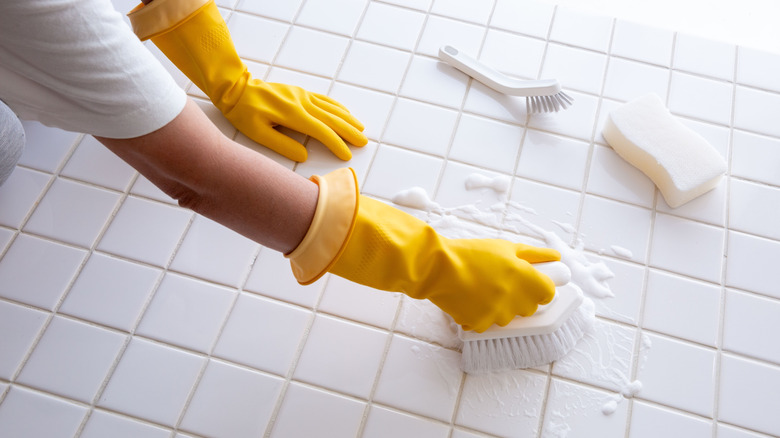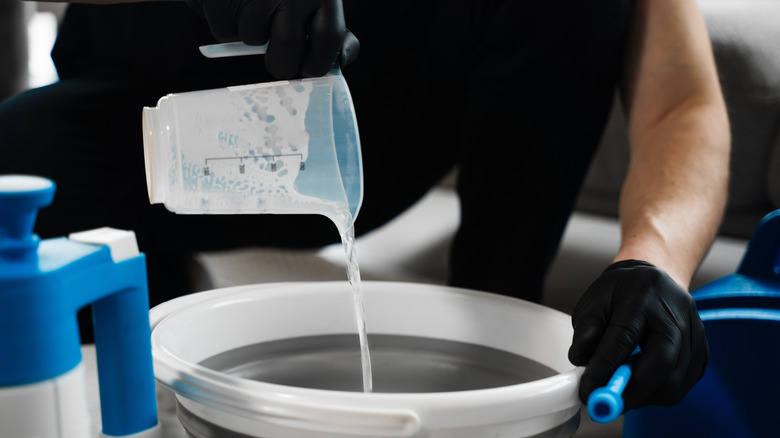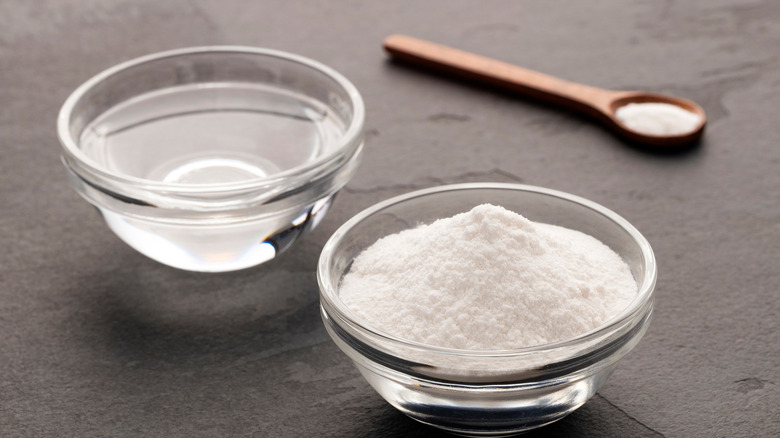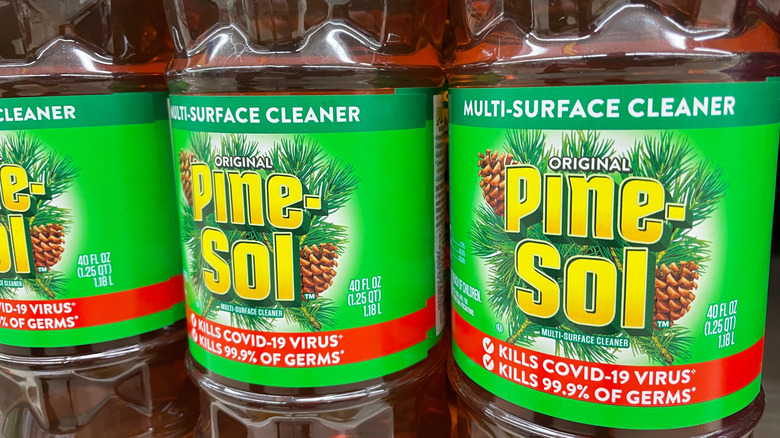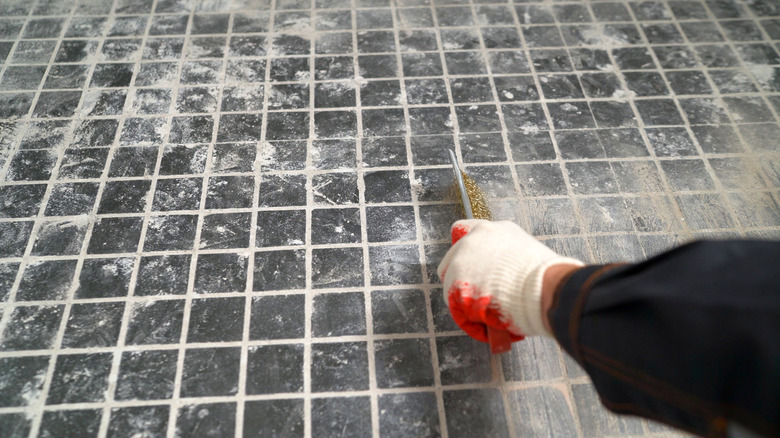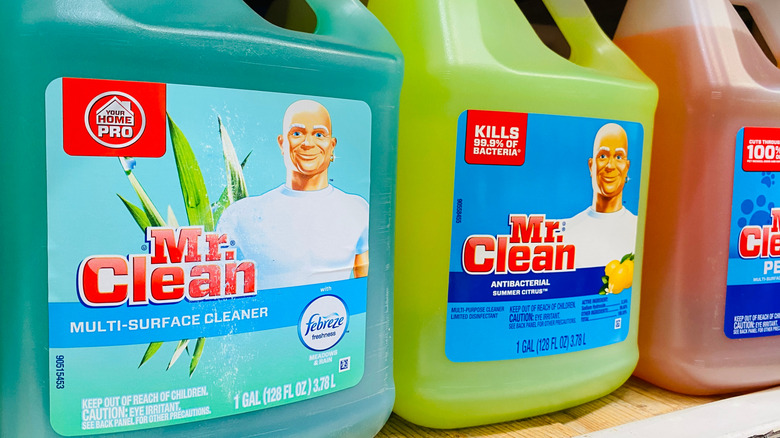The Worst Tile And Grout Cleaners And Methods To Avoid (And Better Solutions To Try)
Tile offers a beautiful, durable option for floors, walls, and backsplashes. You need to use grout when installing tile to make the project last. Not only does it fill the gaps to give the floor a finished look, but it also keeps dirt and debris out of the gaps and adds strength to the tiles to help them last longer. As beneficial as grout is, it also presents you with a new cleaning challenge. It's not easy to clean dirt, grease, soap scum, and other gunk from the textured cement surface. That might lead you to reach for common household cleaning tools like bleach or scouring pads, but many of those go-to cleaning solutions aren't safe for tiles and grout.
Traditional grout contains mostly cement and sand. The cement component is very sensitive to many harsh chemicals, particular acidic cleaners. Using the wrong cleaner often causes the cement to break down or loosen its bond, which weakens the grout and could make it deteriorate to the point of needing to be replaced. Knowing what to avoid helps you protect your grout lines so they last longer. Once you find a cleaning product that's safe for your grout, you can typically use it on the tile safely as well.
Bleach and bleach-based products
It's a common cleaning tool in many homes, but bleach isn't a good solution for cleaning your tile and grout. Bleach is known for removing stains, so it seems logical to use it for grout staining. However, the chemical is too strong for use on grout.
When you use bleach on grout, the chemical can break down the cement in the grout. Over time, this can cause the material to crack and crumble. If you applied sealant to protect the grout lines, the bleach can also eat away at the protective layer and expose your grout to more moisture and stains. Plus, bleach likely won't give you the aesthetic results you want. The chemical often discolors the grout and leaves it looking blotchy instead of consistently removing stains and leaving it one color. Bleach can also strip the grout of its intended original color, which takes away from the look you designed.
Bleach can also damage your tiles, especially if you use it regularly. It can discolor your tiles just like it does to the grout. You might notice your tiles look dull over time with regular bleach use. Even if you're mainly using the bleach on the tiles, some of it is bound to reach the grout and cause it to deteriorate. When that happens, the tiles can loosen and become damaged.
Acidic cleaners
Many cleaners and pantry staples used for cleaning, including vinegar, are acidic. When you use acidic cleaners on grout, the acids can slowly dissolve the alkaline cement particles, causing your grout to deteriorate. Muriatic acid is a strong chemical that's used for cleaning in tough situations, such as masonry cleaning, but some people use it as a tough cleaner around the house. The acid damages both tiles and grout quickly to the point that you might need to replace the flooring. Muriatic acid and many other acids are also potentially dangerous to you. The fumes can cause respiratory issues, and the corrosive chemical can burn your skin. Combining it with chlorine bleach and many other chemicals creates toxic gas.
Vinegar and lemon juice aren't as strong as muriatic acid, but they're still acidic liquids that can damage grout over time, especially on unsealed grout. Like other acidic cleaners, vinegar and lemon juice dissolve and break bonds in the cement part of the grout mixture. It soaks into the grout where it gradually breaks down the material, creating weak or crumbling grout lines that no longer protect your tiles. If you're trying DIY grout-cleaning methods, avoid using vinegar and lemon juice as part of the combination.
Murphy's Oil Soap, Pine-Sol, and other oil- and wax-based cleaners
Oil- and wax-based cleaners, like Pine-Sol and Murphy's Oil Soap, promise a shiny look on your floor, but that shine isn't usually necessary with tile. Most tile products have a coating that gives them a shiny appearance. The problem with the oil or wax in the cleaning product is that it leaves a coating behind on your floor tiles. That can make them slippery and dangerous. Smooth, high-gloss tiles can be slippery already, especially when they get wet, which is one of the biggest downsides to tile flooring. Adding cleaning products that increase the slipperiness increases the chances of you losing your footing on your tile floor.
Cleaners made with oils or waxes also soak into the grout, even if you try to keep them mainly on the tiles. The result is a tacky film on the grout where dirt, crumbs, and other debris can stick easily. You may find that your floors look dirtier because of this, and it could take more effort to remove that layer of grime the next time you clean.
Scouring products
When you notice tough stains on your grout, you might reach for a powerful cleaning tool to help, but be careful which tools you choose. Steel wool, scouring pads, wire brushes, and other abrasive tools are popular cleaning items that will damage your ceramic floor tiles and grout. The rough textures wear away or gouge the grout surface, weakening it and leaving the edges of the tiles exposed. Abrasive cleaners with gritty additives also wear away at the tile sealant and grout. It could leave tiny scratches on your tiles and erode part of the grout, leaving everything exposed to moisture and dirt.
Even gentler cleaning tools can damage grout when used aggressively and frequently. When you scrub the grout, the top layers can wear away gradually. As the grout wears down, it weakens the remaining material and leaves it susceptible to more damage. If you have an occasional grout stain, you can scrub it gently with a soft cleaning tool. However, it's best to avoid scrubbing on a regular basis.
Grout cleaning options you should use
Since the cement in grout is an alkaline material, it's best to use alkaline cleaners, which won't break down the cement. Commercial alkaline cleaners include Spic and Span and Mr. Clean. Another option is to choose tile and grout cleaner, which is formulated to work safely on the materials.
How you use the cleaner is just as important as which product you choose. Use soft cleaning tools, such as cloths or gentle cleaning brushes, to help remove built-up dirt and grime from the tile. Instead of pushing dirty cleaner and water around the floor, you can use a wet/dry vacuum to remove the water after you clean. Rinsing the floor well after cleaning is important to avoid a film buildup, which can attract more dirt and force you to clean your tiles more often.
Once you get your grout spotless, consider sealing it. Choosing the right grout sealer for your tile and applying it regularly blocks dirt from settling into the porous grout material. It also makes the grout lines easier to clean without resorting to harsher cleaners and tools.
